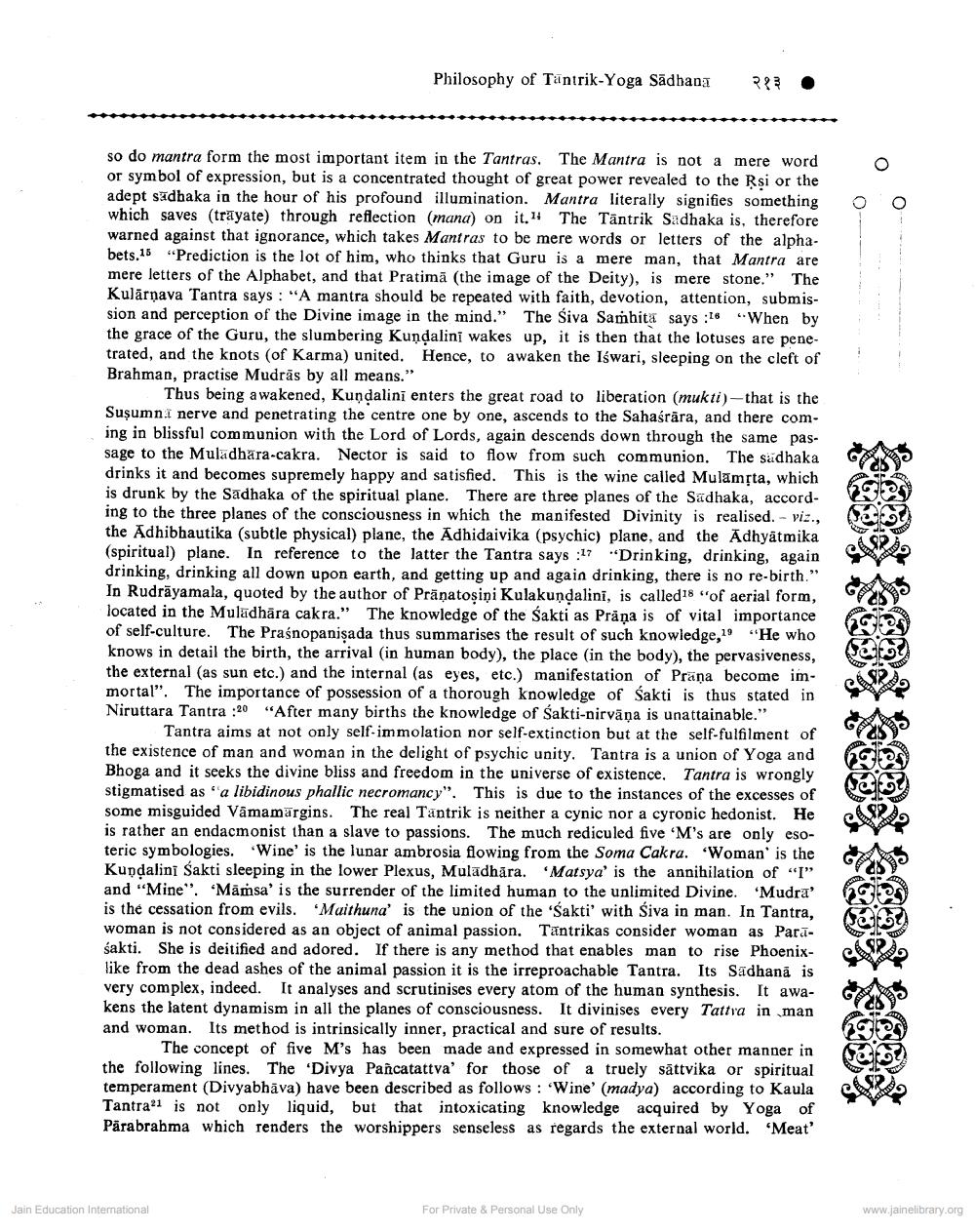Book Title: Philosophy of Tantrik Yoga Sadhna Author(s): Vaishishtha Narain Tripathi Publisher: Z_Pushkarmuni_Abhinandan_Granth_012012.pdf View full book textPage 4
________________ Philosophy of Tantrik-Yoga Sadhana so do mantra form the most important item in the Tantras. The Mantra is not a mere word or symbol of expression, but is a concentrated thought of great power revealed to the Rși or the adept sädhaka in the hour of his profound illumination. Mantra literally signifies something which saves (trayate) through reflection (mana) on it. The Tantrik Sadhaka is, therefore warned against that ignorance, which takes Mantras to be mere words or letters of the alphabets.15 "Prediction is the lot of him, who thinks that Guru is a mere man, that Mantra are mere letters of the Alphabet, and that Pratima (the image of the Deity), is mere stone." The Kulārņava Tantra says: "A mantra should be repeated with faith, devotion, attention, submission and perception of the Divine image in the mind." The Siva Samhita says:16 "When by the grace of the Guru, the slumbering Kundalini wakes up, it is then that the lotuses are penetrated, and the knots (of Karma) united. Hence, to awaken the Iswari, sleeping on the cleft of Brahman, practise Mudras by all means." २१३ Thus being awakened, Kundalini enters the great road to liberation (mukti)-that is the Suşumna nerve and penetrating the centre one by one, ascends to the Sahasrara, and there coming in blissful communion with the Lord of Lords, again descends down through the same passage to the Muladhara-cakra. Nector is said to flow from such communion. The sadhaka drinks it and becomes supremely happy and satisfied. This is the wine called Mulamṛta, which is drunk by the Sadhaka of the spiritual plane. There are three planes of the Sadhaka, according to the three planes of the consciousness in which the manifested Divinity is realised. - viz., the Adhibhautika (subtle physical) plane, the Adhidaivika (psychic) plane, and the Adhyatmika (spiritual) plane. In reference to the latter the Tantra says:17 "Drinking, drinking, again drinking, drinking all down upon earth, and getting up and again drinking, there is no re-birth." In Rudrayamala, quoted by the author of Pränatoșini Kulakundalini, is called18 "of aerial form, located in the Muladhara cakra." The knowledge of the Sakti as Prana is of vital importance of self-culture. The Praśnopanisada thus summarises the result of such knowledge,19 "He who knows in detail the birth, the arrival (in human body), the place (in the body), the pervasiveness, the external (as sun etc.) and the internal (as eyes, etc.) manifestation of Prana become immortal". The importance of possession of a thorough knowledge of Sakti is thus stated in Niruttara Tantra :20 "After many births the knowledge of Śakti-nirvana is unattainable." Jain Education International Tantra aims at not only self-immolation nor self-extinction but at the self-fulfilment of the existence of man and woman in the delight of psychic unity. Tantra is a union of Yoga and Bhoga and it seeks the divine bliss and freedom in the universe of existence. Tantra is wrongly stigmatised as "a libidinous phallic necromancy". This is due to the instances of the excesses of some misguided Vamamärgins. The real Tantrik is neither a cynic nor a cyronic hedonist. He is rather an endacmonist than a slave to passions. The much rediculed five 'M's are only esoteric symbologies. 'Wine' is the lunar ambrosia flowing from the Soma Cakra. 'Woman' is the Kundalini Sakti sleeping in the lower Plexus, Muladhara. 'Matsya' is the annihilation of "I" and "Mine". Mämsa' is the surrender of the limited human to the unlimited Divine. 'Mudra' is the cessation from evils. Maithuna' is the union of the 'Sakti' with Siva in man. In Tantra, woman is not considered as an object of animal passion. Tantrikas consider woman as Paraśakti. She is deitified and adored. If there is any method that enables man to rise Phoenixlike from the dead ashes of the animal passion it is the irreproachable Tantra. Its Sadhana is very complex, indeed. It analyses and scrutinises every atom of the human synthesis. It awakens the latent dynamism in all the planes of consciousness. It divinises every Tattva in man and woman. Its method is intrinsically inner, practical and sure of results. The concept of five M's has been made and expressed in somewhat other manner in the following lines. The 'Divya Pañcatattva' for those of a truely sattvika or spiritual temperament (Divyabhava) have been described as follows: 'Wine' (madya) according to Kaula Tantra is not only liquid, but that intoxicating knowledge acquired by Yoga of Parabrahma which renders the worshippers senseless as regards the external world. 'Meat' For Private & Personal Use Only 23 & www.jainelibrary.orgPage Navigation
1 2 3 4 5 6 7 8 9
